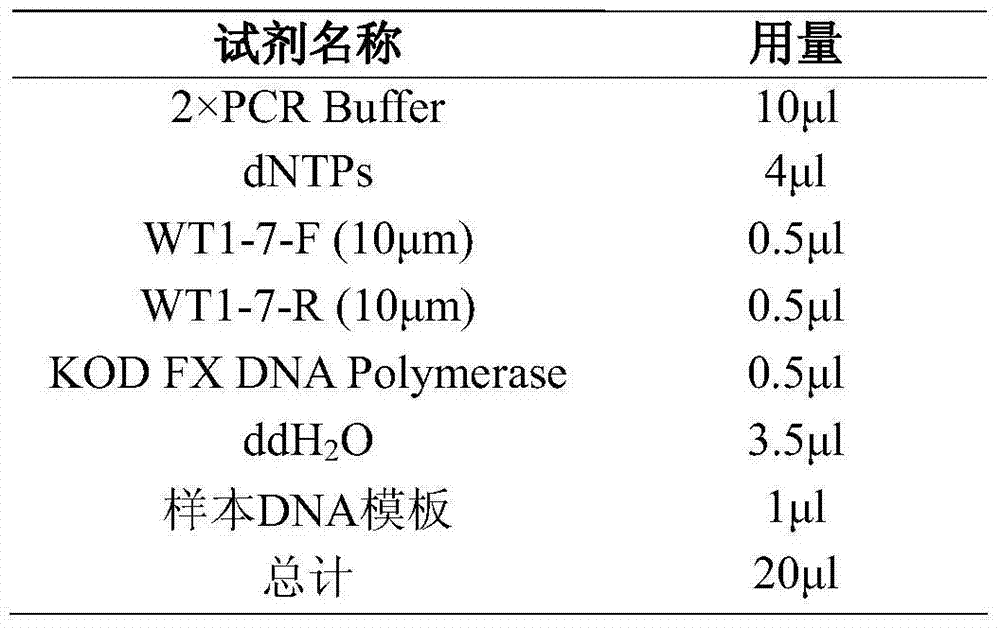Method and primer for detection of polymorphic site of seventh exon of WT1 gene
A polymorphic site and exon technology, applied in the fields of life science and biology, can solve the problems of single, low abundance of non-specific amplification products, achieve simple operation, optimal amplification efficiency, and improve amplification specific effect
- Summary
- Abstract
- Description
- Claims
- Application Information
AI Technical Summary
Problems solved by technology
Method used
Image
Examples
Embodiment 1
[0039] Primers and kits for detecting the polymorphic site of exon 7 of WT1 gene:
[0040] Primers for detecting the polymorphic site of exon 7 of WT1 gene, said primers include: forward and reverse amplification primers for amplifying the polymorphic site of exon 7 of WT1 gene, and its base sequence for:
[0041] WT1-7-F: GGATCTGGAGTGTGAATGG
[0042] WT1-7-R: TTCTAACACCAACACGATTC.
[0043] Preferably, the primers also include a pair of sequencing primers, the base sequence of which is:
[0044] WT1-7-S-F: GGATCTGGAGTGTGAATGG
[0045] WT1-7-S-R: TTCTAACACCAACACGATTC.
[0046] A kit for detecting the polymorphic site of exon 7 of WT1 gene, the kit includes sample DNA extraction reagent, absolute ethanol, detection system PCR reaction solution, sequencing system reaction solution, positive control substance, negative Control substance and blank control substance, the detection system PCR reaction solution includes 2×PCR Buffer, dNTPs, KOD FX DNA Polymerase, ddH 2 O and a p...
Embodiment 2
[0063] Detection process:
[0064] (1) Use the blood DNA extraction kit (Tiangen Biology) to extract tissue DNA from blood:
[0065] 1) Take 500uL of blood and add 1000uL of red blood cell lysate, mix by inversion, and let stand at room temperature for 5 minutes, during which time, invert and mix several times. Centrifuge at 3000rpm for 5min, suck off the supernatant, leave the white blood cell pellet, add 200uL buffer GA, shake until thoroughly mixed.
[0066] 2) Add 20 μl proteinase K solution and mix well.
[0067] 3) Add 200 μl of buffer GB, mix thoroughly by inversion, place at 70°C for 10 minutes, the solution should become clear, and briefly centrifuge to remove water droplets on the inner wall of the tube cap.
[0068] 4) Add 200 μl of absolute ethanol, vortex and mix well for 15 seconds. At this time, flocculent precipitates may appear. Briefly centrifuge to remove water droplets on the inner wall of the tube cap.
[0069] 5) Add the solution and flocculent precipi...
Embodiment 3
[0096] The detection kit of the present invention is used to detect clinical samples.
[0097] Twenty cases of anticoagulated blood samples from patients with acute myeloid leukemia (AML) were taken for inspection, and the genomic DNA in the samples was extracted, reagents were prepared, electrophoresis and sequencing were performed according to the detection process described in Example 2.
[0098] Add 2 ul of the genomic DNA solution of each sample extracted according to the detection process described in Example 2 into the PCR reaction solution of the detection system. Do positive, negative and blank controls at the same time. A 96-well ordinary PCR machine can detect 46 samples at the same time. Each sample is repeated twice, one positive control, one negative control and one blank control. The detection time is 160 minutes.
[0099] After each sample has been sequenced twice, the mutation status will be compared, and a third sequence will be performed for samples with in...
PUM
 Login to View More
Login to View More Abstract
Description
Claims
Application Information
 Login to View More
Login to View More - R&D
- Intellectual Property
- Life Sciences
- Materials
- Tech Scout
- Unparalleled Data Quality
- Higher Quality Content
- 60% Fewer Hallucinations
Browse by: Latest US Patents, China's latest patents, Technical Efficacy Thesaurus, Application Domain, Technology Topic, Popular Technical Reports.
© 2025 PatSnap. All rights reserved.Legal|Privacy policy|Modern Slavery Act Transparency Statement|Sitemap|About US| Contact US: help@patsnap.com



